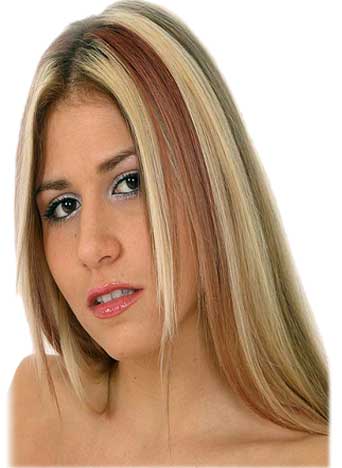BizHat.com > Beauty > Beautiful Hair > Home Hair Color
At-home Hair Color: Seven Tips for Great Results

Doing your own home hair color for the first time can be
intimidating, to say the least. Have I chosen the right
color? What if I make a mistake and wind up with green hair?
What if I end up with overprocessed, dry damaged hair?
The fact is that you can achieve excellent results and save
a lot of money by coloring your hair at home as long as you
know a few basics about how to select the right color and
apply it correctly.
Here are seven of the most common questions and my advice
on hair coloring at home.
Advice on Permanent Hair Coloring at Home
1. How do I know whether I should color my hair at home or
go to a salon?
Most people can successfully color their hair
at home but there are exceptions. You should get a professional
color job if your hair is in poor condition - coloring dry
damaged hair at home can result in uneven color. Also, if your
hair has different shades and you want one even tone, a hairdresser
can apply different formulas to the different areas. Finally, it's
best to leave it to the experts if you want to make a drastic
change to your hair color, say dark brown to platinum blonde, or
you want special color effects or highlights.
2. Are drugstore hair colors just as good as salon hair color
products?
In general, salon hair colors contain higher-quality ingredients
than the drugstore brands. Salons also offer a wider variety of
colors and tones. But home coloring kits are getting better all
the time and can deliver good results if used properly.
3. How do I pick a color that will look natural on me?
When choosing a hair color, your skin tone and natural hair color
are the two most important factors. Whether you're going lighter
or darker, stay within two or three shades of your natural hair
color. Here is a guideline for selecting a compatible hair color
for your skin tone:
- Dark/olive skin: Stay with darker hair colors.
- Yellow skin: Dark, rich colors like deep auburn.
- Pale skin: Almost any color.
- Pink skin: Neutral tones like sandy or beige blonde or chocolate brown
are best. Avoid reds or golden tones.
If you know what clothing colors suit you, you can also use that to help
in choosing hair color:
- If you look good in warm shades like red, orange, golden yellow, cinnamon
brown, olive green, and rust, then warm hair tones like golden blonde,
golden brown, strawberry blonde, and auburn will suit you best.
- Cool color favorites like bluish red, fuschia, black, royal blue, and
pine green indicate that cool hair tones are best for you: platinum,
ash blonde, ash brown, burgundy, and jet black.
- If you look good in true red, purple, charcoal grey, periwinkle, and
teal, then neutral tones like sandy or beige blonde, chocolate brown
or mahogany will suit you.
4. How do I get ready to color my hair the first time?
It's a good idea to gather a few materials together before starting:
an old T-shirt, a few old towels and a washcloth that you don't mind
getting stained, some hair clips for sectioning your hair, a timer,
and a hand mirror to see the back of your head.
5. If I color my hair at home and hate it, what can I do?
There are some home hair color products you can use to repair the
damage, but it isn't easy. The problem is that if you used a home
hair color kit to obtain a lighter color, your hair has been bleached
and colored in a single process. So the color needs to be added back
in a process called "filling" before using the final color formula.
Whatever you do, don't simply buy a box of your original color and
try to cover over a bad dye job... it won't work. Fixing hair color
gone wrong is a multi-stage process so a trip to the salon may be
in order.
6. I already have permed hair. Can I color it without damaging it?
If your hair has been permed or relaxed, color has to be applied
carefully or it can weaken the structure of your hair. Salons have
colors specially formulated for treated hair. But if you insist on
home hair coloring, choose a shade darker than you want since
processed hair may come out lighter than expected. Then do a strand
test to make sure your hair can handle the chemical stress.
7. I love my new color... now how do I keep it looking good?
You'll probably want to recolor every four to six weeks. Make a
record of the hair color product and shade you used, and how long
you left it on the ends and the regrowth. Use shampoos and conditioners
formulated for color-treated hair to prevent fading. Stay out of the
sun and chlorinated pools. Hair that has been previously been bleached is
prone to such effects and should be rinsed as soon as possible. Don't use
heavy conditioners and oil treatments after coloring... they can lift
the color.
|

